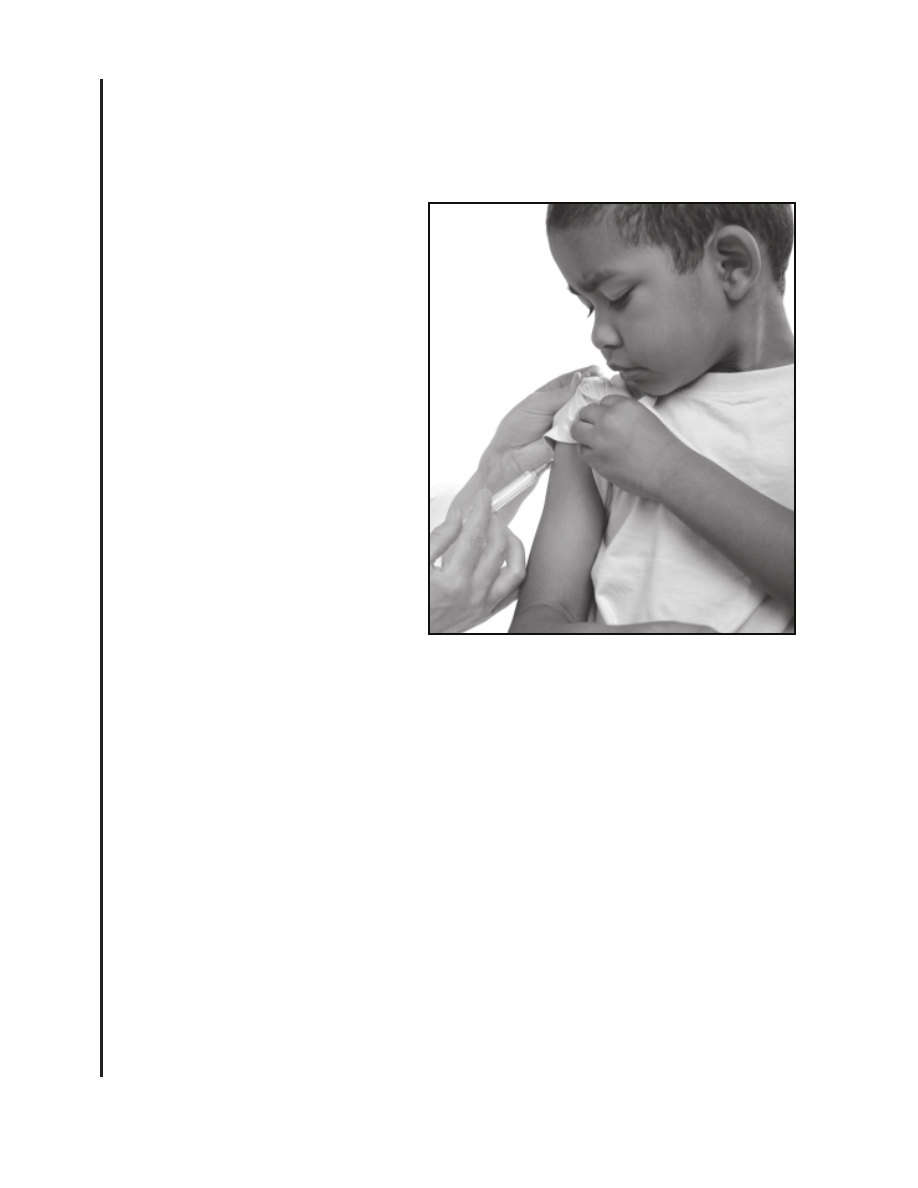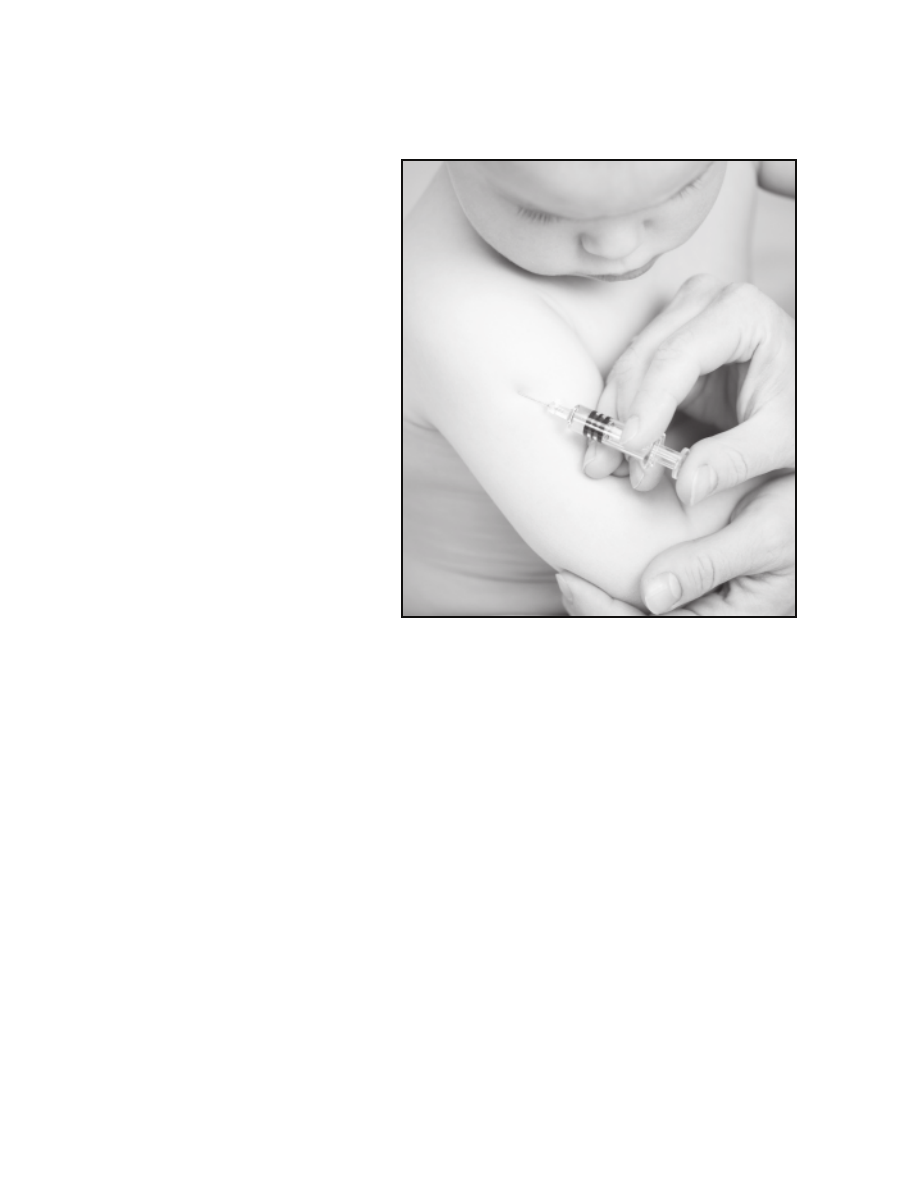ВУЗ: Не указан
Категория: Не указан
Дисциплина: Не указана
Добавлен: 06.12.2020
Просмотров: 1092
Скачиваний: 3

38
Lecture 10: V
accination Bene
¿
ts—How W
ell V
accines W
o
rk
The next type of vaccine is the inactivated vaccine. Here you take a virus or
bacteria and essentially kill it. You inactivate it so that it cannot reproduce,
but it still has all the proteins on the outside. There is a small risk of
infection with an inactivated
vaccine—but only if the virus
is improperly inactivated.
With proper inactivation,
there is zero risk of infection.
Inactivated vaccines may not
be quite as effective as a live
vaccine. For this reason, they
are more likely to require
booster shots.
Then there are subunit
vaccines. These contain not
even an entire virus—just
part of the protein shell, for
example. Here, there is no
risk of infection. Conjugate
vaccines combine a toxin or
an immunogenic protein to
the coat, because certain coats
are not very immunogenic. But, if you couple it with something else—a
toxin or something that’s really good at stimulating the immune system—the
immune system will be activated against it.
Toxoid vaccines are vaccines not against the organism of a virus or bacteria,
but against a toxin that the virus produces. Toxoid vaccines do not prevent
an infection, but the antibodies will bind and inactivate the toxin as it’s being
released. Therefore, it will prevent the negative health consequences of the
infection while allowing the infection to run its normal course.
Do vaccines work? There are still today people who question whether
vaccines work. But the evidence is extremely clear: Vaccines are about
95% effective. This means that 95% of people who are vaccinated with
a vaccination schedule—which may involve boosters—will develop a
Modern vaccines are about 95% effective.
© iStockphoto/Thinkstock.
39
functional immunity to the substance against which they’re being vaccinated.
Vaccines are less effective in elderly and immunocompromised people. That
is a serious concern because those are often the very people that we need to
protect the most.
This leads us to the concept of herd immunity. There are estimates that
when about 90% or more of any population—people who are likely to be
exposed to each other—are vaccinated against an infection, you achieve herd
immunity. That infection cannot easily spread from person to person. Anyone
who is harboring the virus or bacteria is very unlikely to encounter somebody
else who isn’t immune. Therefore, they’ll be able to
¿
ght it off before they
spread it around. This prevents outbreaks and also prevents infections from
being endemic.
Ŷ
Allen,
Vaccine
.
Henderson,
Smallpox.
1.
How do vaccines work?
2.
How much evidence is there for the safety and effectiveness
of vaccines?
Suggested Reading
Questions to Consider
40
Lecture 1
1: V
accination Risks—Real and Imagined
Vaccination Risks—Real and Imagined
Lecture 11
Rumors began to spread that squalene in the vaccines given to Gulf
War veterans was linked to Gulf War Syndrome. The gaping hole in
this hypothesis, however, is that squalene was never even in the vaccines
that those soldiers were given.
C
ontinuing our discussion of vaccines, I’m going to turn now to talking
about some myths about fears and about the safety of vaccines. We
begin with a well-known myth about autism. A UK physician named
Andrew Wake
¿
eld published a 1998 paper in
The Lancet
that claimed that
he found a correlation between autism, which is a neurodevelopmental
disorder; gastrointestinal disorders; and infection with the measles virus. The
paper did not directly implicate vaccines. However, in the subsequent press
conferences and media contacts that Wake
¿
eld had, he speci
¿
cally spread
concerns about the MMR (mumps, measles, and rubella) vaccine being
linked to this gastrointestinal-autism disorder connection. MMR fears spread
from that point for the following decade and beyond.
In the UK, vaccination rates with the MMR vaccine dropped from about 92%
in 1996 down to as low as 84% in 2002. In some parts of London, compliance
rates were as low as 61% in 2003. That’s a dramatic decrease in the number
of people willing to take the MMR vaccine or give it to their children.
These rates are low enough that they’re below herd immunity. That’s that
magic number of people who are vaccinated—around 90%—that prevents
the endemic spread of an infection. This subsequently led to outbreaks of
diseases that had been previously removed as endemic in the UK, such as
measles. A similar thing happened shortly after that in the United States:
The rates dropped, particularly in certain populations, and those populations
became susceptible to previously eliminated diseases.
Wake
¿
eld was later found to have undisclosed con
À
icts of interest. He was
actually applying for a patent for a replacement measles vaccine. He was also
being funded by lawyers who were engaged in lawsuits on behalf of parents
who were claiming that their children’s autism was caused by the MMR

41
vaccine. Even later, there were allegations made that the data in his original
Lancet
paper, or some of that data, may have been faked. This is because it
didn’t square with hospital
records that were then re-
reviewed. In 2010, based on
these undisclosed con
À
icts
of interest and these
allegations,
The Lancet
actually withdrew his paper
from the published record.
Wake
¿
eld was found guilty
of professional misconduct
in the UK and no longer
has a license to practice
medicine there. However,
the damage had already
been done. Fears about a
correlation between the
MMR vaccine and autism
were already spreading.
A 2010 survey found that as
many as 25% of U.S. parents
think there is a link between
vaccines and autism. In that same survey, 9 in 10 parents think that vaccines
are important to the health of their children. This indicates that there’s a
certain amount of confusion in the general population about the safety
of vaccines.
Ultimately the question of the safety of vaccines is not about the ethics or
the research of one scientist; it’s about the scienti
¿
c evidence. There have
been a number of studies on whether there really is a connection between the
MMR vaccine and autism or other neurodevelopmental disorders. Data from
Poland, the UK, Denmark, Finland, and Japan all independently found that
there is no connection whatsoever between MMR and autism.
Independent studies in several countries
found no connection between the MMR
vaccine and autism.
© iStockphoto/Thinkstock.
42
Lecture 1
1: V
accination Risks—Real and Imagined
In the years following Wake
¿
eld, when research was progressively clearing
MMR vaccine as a correlation with autism, those who were having fears
about the MMR vaccine shifted to fears about thimerosal. Thimerosal is in
some vaccines, but was never in the MMR vaccine. It is a mercury-based
preservative added mainly to multidose vials or some inactivated vaccines
to prevent bacterial contamination.
It has been used for decades in
many health and beauty products,
not just vaccines.
The question is whether the
ethylmercury in thimerosal is
toxic to people—and speci
¿
cally
to children—in the doses that you
get from the vaccines. Mercury certainly is a neurotoxin; nobody denies
that. The toxicology of mercury is pretty clear. However, autism does not
resemble mercury toxicity. They’re both neurological disorders, but the
details of the signs and symptoms are different enough that we can say
they’re distinct disorders.
Over the last decade, there have been multiple studies in multiple countries
looking at any correlation between exposure to thimerosal and the risk of
developing either autism speci
¿
cally or neurodevelopmental disorders
in general. These studies have shown no correlation. Most signi
¿
cantly,
in the United States the government decided to remove thimerosal almost
completely from the routine childhood vaccine schedule. This removal was
completed certainly by the beginning of 2002. The result of this was that
the cumulative dose that children were exposed to from the entire vaccine
schedule has been dramatically decreased. Those who were most vociferous
about a connection between thimerosal and autism predicted that autism rates
would plummet after the removal of thimerosal from the vaccine program.
This did not happen. In fact, the autism rates continue to increase at exactly
the same rate.
There are other vaccine myths that have cropped up as well. One myth is that
we don’t need to vaccinate against diseases that are no longer endemic. But
the only time we can really safely stop using a vaccine is when a disease is
I think of all the myths that I
cover in this course, myths
surrounding vaccines have the
potential to do the most harm.